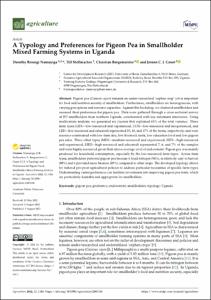A Typology and Preferences for Pigeon Pea in Smallholder Mixed Farming Systems in Uganda

A Typology and Preferences for Pigeon Pea in Smallholder Mixed Farming Systems in Uganda

| dc.contributor.author | Birungi Namuyiga, Dorothy | |
| dc.contributor.author | Stellmacher, Till | |
| dc.contributor.author | Borgemeister, Christian | |
| dc.contributor.author | Groot, Jeroen | |
| dc.date.accessioned | 2023-04-28T11:53:52Z | |
| dc.date.available | 2023-04-28T11:53:52Z | |
| dc.date.issued | 09.08.2022 | |
| dc.identifier.uri | https://hdl.handle.net/20.500.11811/10804 | |
| dc.description.abstract | Pigeon pea (Cajanus cajan) remains an under-researched ‘orphan crop’ yet is important for food and nutrition security of smallholders. Furthermore, smallholders are heterogeneous, with varying perceptions and resource capacities. Against this backdrop, we clustered smallholders and assessed their preferences for pigeon pea. Data were gathered through a cross-sectional survey of 257 smallholders from northern Uganda, corroborated with key informant interviews. Using multivariate analysis, we generated six clusters that explained 63% of the total variance. Three farm types (LEX—low-resourced and experienced, LUN—low-resourced and inexperienced, and LED—low-resourced and educated) represented 15, 10, and 17% of the farms, respectively, and were resource-constrained with low farm size, low livestock units, low education level and low pigeon pea sales. Three other types (MEX—medium-resourced and experienced, HEX—high-resourced and experienced, HED—high-resourced and educated) represented 7, 6, and 7% of the samples and were highly-resourced given their above-average level of endowment. Pigeon pea was mainly produced for household consumption, especially by the low-resourced farm types. Across farm types, smallholders preferred pigeon pea because it fixed nitrogen (94%), is relatively easy to harvest (90%) and it provided more biomass (89%) compared to other crops. The developed typology allows for tailored pro-poor agricultural policies to address particular necessities of specific farm types. Understanding varied preferences can facilitate investments into improving pigeon pea traits, which are particularly desirable and appropriate for smallholders. | en |
| dc.format.extent | 15 | |
| dc.language.iso | eng | |
| dc.rights | Namensnennung 4.0 International | |
| dc.rights.uri | http://creativecommons.org/licenses/by/4.0/ | |
| dc.subject | pigeon pea | |
| dc.subject | preference | |
| dc.subject | endowment | |
| dc.subject | smallholders | |
| dc.subject | typology | |
| dc.subject | Uganda | |
| dc.subject.ddc | 630 Landwirtschaft, Veterinärmedizin | |
| dc.title | A Typology and Preferences for Pigeon Pea in Smallholder Mixed Farming Systems in Uganda | |
| dc.type | Wissenschaftlicher Artikel | |
| dc.publisher.name | MDPI | |
| dc.rights.accessRights | openAccess | |
| dcterms.bibliographicCitation.volume | 2022, vol. 12 | |
| dcterms.bibliographicCitation.issue | iss. 8 | |
| dcterms.bibliographicCitation.pagestart | 1 | |
| dcterms.bibliographicCitation.pageend | 15 | |
| dc.relation.doi | https://doi.org/10.3390/agriculture12081186 | |
| dcterms.bibliographicCitation.journaltitle | Agriculture | |
| ulbbn.pubtype | Zweitveröffentlichung | |
| dc.version | publishedVersion | |
| ulbbn.sponsorship.oaUnifund | OA-Förderung Universität Bonn |
Files in this item
This item appears in the following Collection(s)
-
Publikationen (31)




